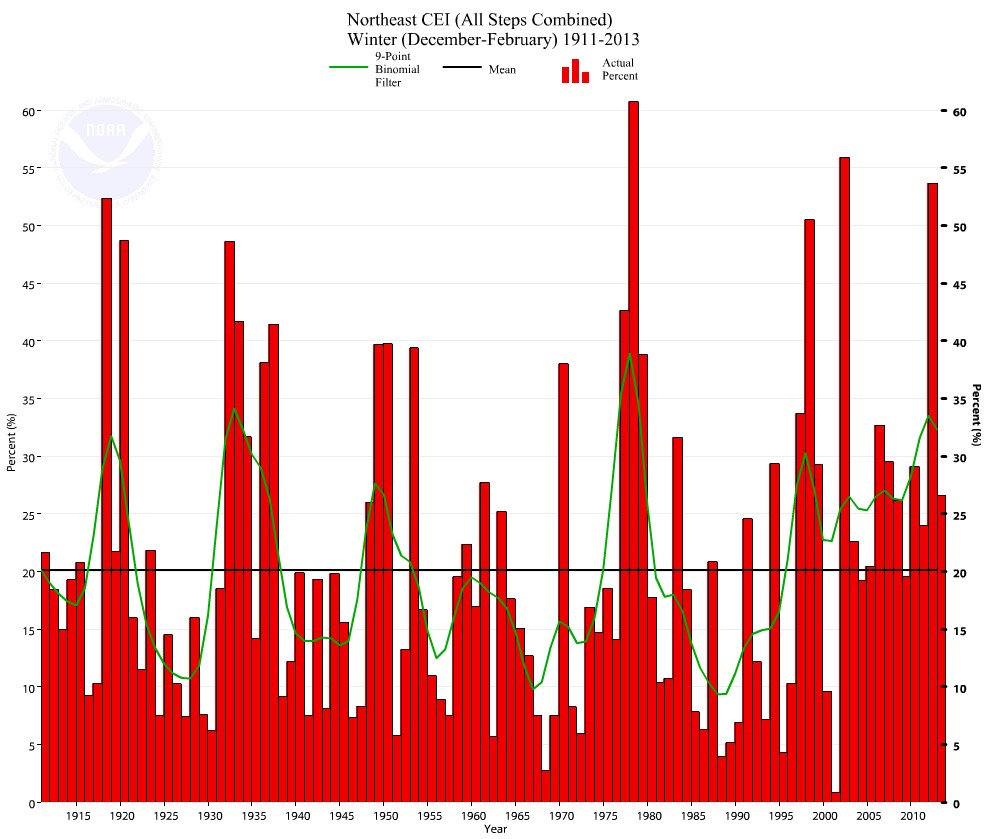NOAA has put out their Climate Extremes Index for winter 2012-2013. The graph below highlights how depraved their climate fraud has become.
Last winter had essential no extreme weather in the northeast, and was rated the third most extreme winter in history. This year had lots of snow and storms, and was rated only half as extreme as last year’s storm free winter.



Any comment on how they do their calculations?
http://www.ncdc.noaa.gov/extremes/cei/graph/ne/cei/12-02
Too early in the morning for me…
“For landfalls from 1980 to the present: Use estimated landfalling windspeed as reproted in the Tropical Cyclone Reports issued by the National Hurricane Center.”
Apparently they hired their editor from The Grauniad. Good enough for gubmint work. 😉
Wrong, they just take stuff put together by outfits like Union of Concerned Scientists and they add some verbiage and fake diagrams to make it worse.
Tonight’s weather is brought to you by … Tom Karl, with a hair piece as bad as his desire to please extreme environmental groups
NOAA Sinkhole.
FOX is not much better with their ‘Extreme Weather Alerts”, and spinning red planet logo.
Of course, if you believe in our founding document, your views are ‘extreme’.
“Extreme: situated at the farthest possible point from a center”
In the known history of man Freedom is an extreme.
People won’t have it if they don’t want it. It is evident that people who go along with this, simply don’t want it.
They need to be told what to do
Agreed. Freedom is definitely NOT the default position of mankind.
None of that extreme sunbathing in Traverse City like last March.
Since the title of this post has the word ‘Depravity’ in it, I’ll just post this here…
“Sister Marguerite Kloos also faces one count of illegal voting, for allegedly submitting an absentee ballot in the name of a fellow nun, Sister Rose Marie Hewitt, who had died before absentee ballots were sent out. She is accused of opening Sister Hewitt’s ballot, forging her signature and mailing it to the Board of Elections as a vote.
The 54-year-old Kloos has resigned as the dean of the Division of Arts and Humanities at the College of Mount St. Joseph in Cincinnati, where she still serves as an associate professor of religious and pastoral studies.”
Read more: http://www.foxnews.com/politics/2013/03/11/cincinnati-poll-worker-charged-with-voting-half-dozen-times-in-november/#ixzz2NNCpOhnJ
Is nothing sacred anymore?
Its so heavily biased toward temps that even two gigantic snowstorms will not phase that number.
Reblogged this on Climate Ponderings.
In order to interpret this graph you need to know what it represents, as follows (from NOAA web site)
The U.S. Climate Extremes Index (CEI) was proposed in 1995 as a framework for quantifying observed changes in climate within the contiguous United States. The CEI is based on a set of climate indicators: extremes in monthly mean maximum and minimum temperatures, heavy 1-day precipitation events, drought severity, the number of days with/without precipitation, and wind intensity of landfalling tropical cyclones.
A CEI value of 0 percent, the lower limit, indicates that no portion of the country was subject to any of the extremes of temperature or precipitation considered in the index. In contrast, a value of 100 percent would mean that the entire country had extreme conditions throughout the time period for each of the indicators, a virtually impossible scenario. Since we’re dealing with the upper and lower tenth percentile as a definition of the extremes, and we’re looking at the cold and warm (wet and dry) ends of the extremes, the long-term average expected percent area experiencing extremes is 20 percent. Therefore, observed CEI values of more than 20 percent indicate “more extreme” conditions than average, and CEI values less than 20 percent indicate “less extreme” conditions than average.
The CEI is evaluated for eight seasons: spring, summer, autumn, winter, annual, cold season, warm season, and hurricane season. Data and graphics for each season and indicator are updated at the beginning of the month. CEI results indicate that for the annual, summer, warm and hurricane seasons, the percent of the contiguous United States experiencing extreme conditions has been generally increasing since the early 1970s (see figure). Recent percentages are similar to those found during the early 1900s for these same periods.
Data and graphics for the most current CEI and the individual indicators within it are available online at http://www.ncdc.noaa.gov/extremes/cei/.
Here is the source for the graphs … you can choose by region
http://www.ncdc.noaa.gov/extremes/cei/graph/ne/cei/01-12
If anyone else faked data like this they would be arrested and detained indefinitely?